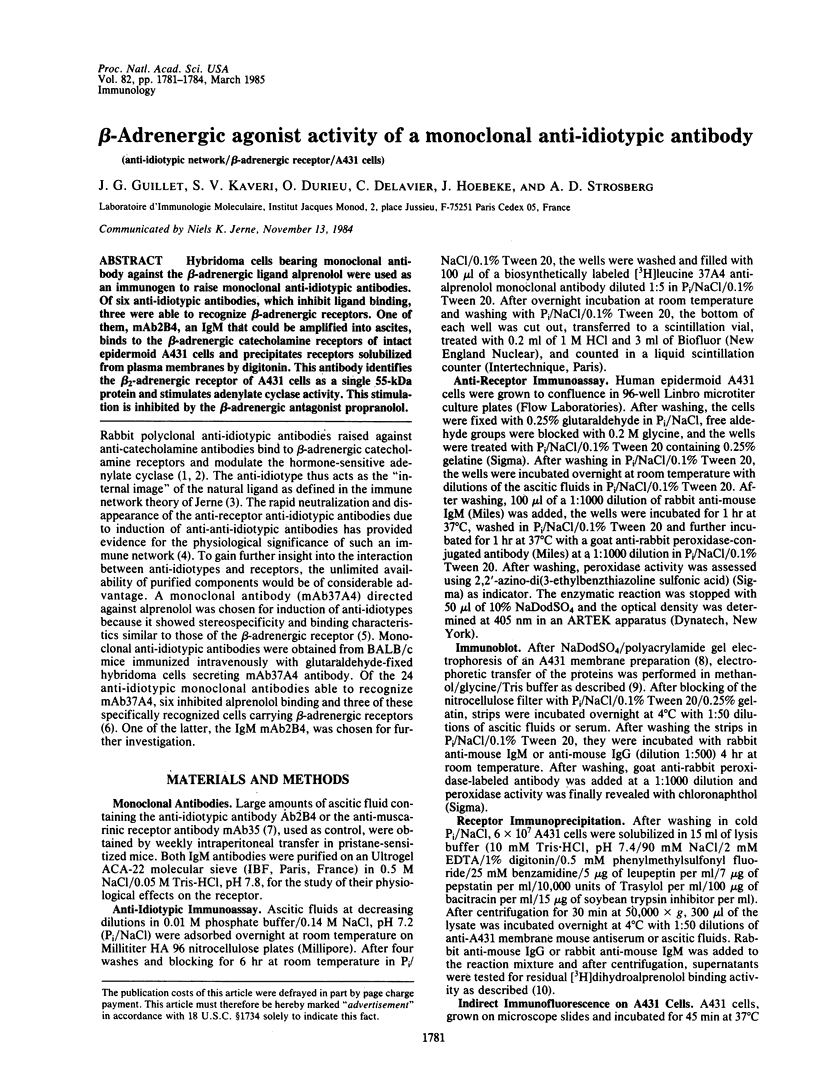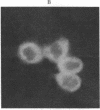Abstract
Hybridoma cells bearing monoclonal antibody against the beta-adrenergic ligand alprenolol were used as an immunogen to raise monoclonal anti-idiotypic antibodies. Of six anti-idiotypic antibodies, which inhibit ligand binding, three were able to recognize beta-adrenergic receptors. One of them, mAb2B4, an IgM that could be amplified into ascites, binds to the beta-adrenergic catecholamine receptors of intact epidermoid A431 cells and precipitates receptors solubilized from plasma membranes by digitonin. This antibody identifies the beta 2-adrenergic receptor of A431 cells as a single 55-kDa protein and stimulates adenylate cyclase activity. This stimulation is inhibited by the beta-adrenergic antagonist propranolol.
Full text
PDF



Images in this article
Selected References
These references are in PubMed. This may not be the complete list of references from this article.
- André C., Guillet J. G., De Backer J. P., Vanderheyden P., Hoebeke J., Strosberg A. D. Monoclonal antibodies against the native or denatured forms of muscarinic acetylcholine receptors. EMBO J. 1984 Jan;3(1):17–21. doi: 10.1002/j.1460-2075.1984.tb01755.x. [DOI] [PMC free article] [PubMed] [Google Scholar]
- Chamat S., Hoebeke J., Strosberg A. D. Monoclonal antibodies specific for beta-adrenergic ligands. J Immunol. 1984 Sep;133(3):1547–1552. [PubMed] [Google Scholar]
- Couraud P. O., Lü B. Z., Strosberg A. D. Cyclical antiidiotypic response to anti-hormone antibodies due to neutralization by autologous anti-antiidiotype antibodies that bind hormone. J Exp Med. 1983 May 1;157(5):1369–1378. doi: 10.1084/jem.157.5.1369. [DOI] [PMC free article] [PubMed] [Google Scholar]
- Delavier-Klutchko C., Hoebeke J., Strosberg A. D. The human carcinoma cell line A431 possesses large numbers of functional beta-adrenergic receptors. FEBS Lett. 1984 Apr 24;169(2):151–155. doi: 10.1016/0014-5793(84)80308-7. [DOI] [PubMed] [Google Scholar]
- Durieu-Trautmann O., Delavier-Klutchko C., Vauquelin G., Strosberg A. D. Visualization of the turkey erythrocyte beta-adrenergic receptor. J Supramol Struct. 1980;13(4):411–419. doi: 10.1002/jss.400130402. [DOI] [PubMed] [Google Scholar]
- Guillet J. G., Chamat S., Hoebeke J., Strosberg A. D. Production and detection of monoclonal anti-idiotype antibodies directed against a monoclonal anti-beta-adrenergic ligand antibody. J Immunol Methods. 1984 Nov 16;74(1):163–171. doi: 10.1016/0022-1759(84)90377-6. [DOI] [PubMed] [Google Scholar]
- Harden T. K., Cotton C. U., Waldo G. L., Lutton J. K., Perkins J. P. Catecholamine-induced alteration in sedimentation behavior of membrane bound beta-adrenergic receptors. Science. 1980 Oct;210(4468):441–443. doi: 10.1126/science.6254143. [DOI] [PubMed] [Google Scholar]
- Homcy C. J., Rockson S. G., Haber E. An antiidiotypic antibody that recognizes the beta-adrenergic receptor. J Clin Invest. 1982 May;69(5):1147–1154. doi: 10.1172/JCI110550. [DOI] [PMC free article] [PubMed] [Google Scholar]
- Jerne N. K. Towards a network theory of the immune system. Ann Immunol (Paris) 1974 Jan;125C(1-2):373–389. [PubMed] [Google Scholar]
- Lavin T. N., Nambi P., Heald S. L., Jeffs P. W., Lefkowitz R. J., Caron M. G. 125I-labeled p-azidobenzylcarazolol, a photoaffinity label for the beta-adrenergic receptor. Characterization of the ligand and photoaffinity labeling of beta 1- and beta 2-adrenergic receptors. J Biol Chem. 1982 Oct 25;257(20):12332–12340. [PubMed] [Google Scholar]
- Rashidbaigi A., Ruoho A. E. Photoaffinity labeling of beta-adrenergic receptors: identification of the beta-receptor binding site(s) from turkey, pigeon, and frog erythrocyte. Biochem Biophys Res Commun. 1982 May 14;106(1):139–148. doi: 10.1016/0006-291x(82)92069-1. [DOI] [PubMed] [Google Scholar]
- Schreiber A. B., Couraud P. O., Andre C., Vray B., Strosberg A. D. Anti-alprenolol anti-idiotypic antibodies bind to beta-adrenergic receptors and modulate catecholamine-sensitive adenylate cyclase. Proc Natl Acad Sci U S A. 1980 Dec;77(12):7385–7389. doi: 10.1073/pnas.77.12.7385. [DOI] [PMC free article] [PubMed] [Google Scholar]
- Sege K., Peterson P. A. Use of anti-idiotypic antibodies as cell-surface receptor probes. Proc Natl Acad Sci U S A. 1978 May;75(5):2443–2447. doi: 10.1073/pnas.75.5.2443. [DOI] [PMC free article] [PubMed] [Google Scholar]
- Staehelin M., Simons P., Jaeggi K., Wigger N. CGP-12177. A hydrophilic beta-adrenergic receptor radioligand reveals high affinity binding of agonists to intact cells. J Biol Chem. 1983 Mar 25;258(6):3496–3502. [PubMed] [Google Scholar]
- Steiner A. L., Pagliara A. S., Chase L. R., Kipnis D. M. Radioimmunoassay for cyclic nucleotides. II. Adenosine 3',5'-monophosphate and guanosine 3',5'-monophosphate in mammalian tissues and body fluids. J Biol Chem. 1972 Feb 25;247(4):1114–1120. [PubMed] [Google Scholar]
- Strosberg A. D. Anti-idiotype and anti-hormone receptor antibodies. Springer Semin Immunopathol. 1983;6(1):67–78. doi: 10.1007/BF01857367. [DOI] [PubMed] [Google Scholar]
- Thom D., Powell A. J., Lloyd C. W., Rees D. A. Rapid isolation of plasma membranes in high yield from cultured fibroblasts. Biochem J. 1977 Nov 15;168(2):187–194. doi: 10.1042/bj1680187. [DOI] [PMC free article] [PubMed] [Google Scholar]
- Towbin H., Staehelin T., Gordon J. Electrophoretic transfer of proteins from polyacrylamide gels to nitrocellulose sheets: procedure and some applications. Proc Natl Acad Sci U S A. 1979 Sep;76(9):4350–4354. doi: 10.1073/pnas.76.9.4350. [DOI] [PMC free article] [PubMed] [Google Scholar]
- Vauquelin G., Geynet P., Hanoune J., Strosberg A. D. Affinity chromatography of the beta-adrenergic receptor from turkey erythrocytes. Eur J Biochem. 1979 Aug 1;98(2):543–556. doi: 10.1111/j.1432-1033.1979.tb13215.x. [DOI] [PubMed] [Google Scholar]







